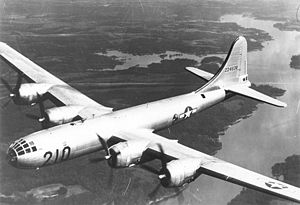WB-29 Superfortress
| B-29 Superfortress | |
|---|---|
 |
|
| Boeing B-29 assigned to B-29 Transition Training School, Maxwell Field, Alabama | |
| Role | Strategic bomber |
| Manufacturer | Boeing |
| First flight | 21 September 1942 |
| Introduction | 8 May 1944 |
| Retired | 21 June 1960 |
| Status | Retired (see Surviving aircraft) |
| Primary users |
United States Army Air Forces United States Air Force Royal Air Force |
| Produced | 1943–1946 |
| Number built | 3,970 |
| Unit cost |
US$639,188
|
| Variants |
All models Boeing KB-29 Superfortress XB-39 Superfortress Boeing XB-44 Superfortress Boeing B-50 Superfortress |
| Developed into |
Tupolev Tu-4 |
The Boeing B-29 Superfortress was produced in a large number of experimental and production models.
The XB-29, Boeing Model 345, was the first accepted prototype or experimental model delivered to the Army Air Corps, incorporating a number of improvements on the design originally submitted, including more and larger guns and self-sealing fuel tanks. Two aircraft were ordered in August 1940, and a third was ordered in December. A mockup was completed in the spring of 1941, and it first flew on September 21, 1942.
Testing continued until February 18, 1943, when the second prototype crashed. Flown by Boeing's chief test pilot, Edmund T. "Eddie" Allen on a two-hour powerplant performance test, leaking fuel from a filler cap in the wing leading edge ran down inside the leading-edge and ignited, spreading to the engines. Due to the much reduced power, the aircraft, unable to climb, crashed into the Frye meat-packing plant, demolishing the majority of the packing plant and killing all eleven crew, 22 employees at the plant and one fireman. The crash killed many élite Boeing personnel involved in the design; the pilot, Allen, was chief of the Research Division. After the crash, the United States Army Air Forces and a congressional committee headed by then-Senator Harry S. Truman investigated the B-29 program issuing a scathing report, prompting the Army Air Forces to take control of the program.
The YB-29 was an improved XB-29 and 14 were built for service testing. Testing began in the summer of 1943, and dozens of modifications were made to the planes. The engines were upgraded from Wright R-3350-13s to R-3350-21s. Where the XB-29 had three-bladed props, the YB-29 had four-bladed propellers. Various alternatives to the remote-controlled defensive systems were tested on a number of them, particularly the fourth one delivered. After alternative arrangements had been fully tested, defensive armament was standardised at ten .50-calibre machine guns in turret-mounted pairs. The YB-29 also featured a better fire control system.
...
Wikipedia
